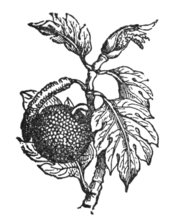The usual materials of bread are flour, yeast and water containing salt. Many of the operations of breadmaking are now carried on by machinery. Some bakeries use 2,000 bags of flour in a week. Brown bread is made from the ground but undressed wheat, and so contains the bran as well as the wheat.

|
| Breadfruit |
Bread′fruit Tree, a native of southern Asia, of the islands of the South Pacific and of the Indian Archipelago. It is now grown also in some of the West Indies. Growing to a height of forty or fifty feet, it has large, dark-green leaves and a sphere-shaped fruit, about the size of a child’s head, weighing sometimes over four pounds. The fruit is the main food of the natives of the South Sea islands. It is covered with a rough rind, and the fruit when ripe is juicy and yellow. It is better, however, before it is fully ripe. When cut up and baked in an oven, it is mealy and nourishing. In taste somewhat sweetish, it is more like a plantain than ordinary wheat bread. When properly cooked, it will keep several weeks. The South Sea natives beat it into a paste, which, slightly fermented, is somewhat sour, but a food they relish. The breadfruit tree will produce two or three crops a year. The wood is used for furniture, for building and for various purposes.
Breakwater, a bank or levee of stones or a timber structure, used to break the violence of the sea in its entrance into a harbor or roadstead. There may be a natural breakwater, as the Isle of Wight, which protects Portsmouth and Southampton. The Romans made artificial breakwaters of some size in several Italian ports. The first modern structure and the greatest of all breakwaters is that at Cherbourg, on the French side of the English Channel. There are also breakwaters in the English harbors of Plymouth, Portland and Holyhead. Several structures of this kind have also been built upon the Great Lakes, as at Buffalo and Cleveland on Lake Erie and at Chicago on Lake Michigan. The one at Buffalo is the largest in the United States. The usual method of building breakwaters is to cast down large stones and allow them to settle under the action of the tides and currents. The top is then covered with large blocks of artificial stone or with paving laid at a regular slope, and a wall is built.

|
| John C. Breckenridge |
Breck′enridge, John Cabell, an American politician and soldier, was born in Kentucky in 1821. He took part in the Mexican War, and afterward became a member of Congress. In 1856 he was elected vice-president, with Buchanan as president, and four years later was one of the Democratic candidates for president, receiving the electoral votes of most of the southern states. He was elected senator, but entered the Confederate army, where he rose to the rank of major-general. In 1865 he was appointed Confederate secretary of war. Later, he practiced law in Kentucky. He died in 1875.
Bremen (brĕm′en or brā́′men), one of the three free cities of Germany, stands on both banks of the Weser, which is spanned by four bridges. Though called a free city, it is really a little state, having an area of 99 square miles, which includes, besides the city itself, the port of Bremerhaven and several other small places. It goes back in history to the time of Charlemagne in the 8th century, was at one time a member of the so-called Hanseatic league of cities, and is now a part of the German empire. It has a senate of sixteen members and a council of 150 burgesses. It has a number of old and interesting buildings, but is especially noted for its large trade, in which it holds the second place among the cities of Germany. Its enormous foreign trade extends all over the world, but is largest with the United States. Its exports to the latter embrace aniline dyes, cotton hosiery, cotton lace, furs, hides, skins and leather manufactures, toys, rubber, woolen cloth, etc. From its port about fifty per cent. of all German emigrants set sail, most of them coming to the United States. In one year 52,000 emigrants left its port, and that same year it imported from the United States goods valued at almost $30,000,000. Twenty-five hundred vessels arrive yearly. It is the headquarters of the North German Lloyd steamship company, and is connected by rail with the whole of western and central Germany. Population of the state is 298,736 and that of the city 246,827.
Bremer (brē′mẽr), Frederika, a well-known Swedish novelist, was born in Finland in 1801, but was brought up near Stockholm, Sweden. She wrote verses as a child; and was well-educated, finishing her
